How To Repair Hairline Cracks in Tile Grout Lines
How To Repair Cracked Grout
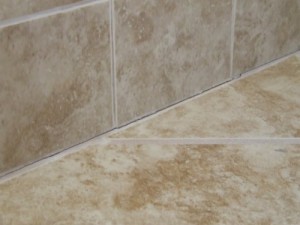 Anyone that’s installed ceramic tile knows that after time you may find narrow cracks in the grout lines. Typically this happens where two perpendicular faces come together.
Anyone that’s installed ceramic tile knows that after time you may find narrow cracks in the grout lines. Typically this happens where two perpendicular faces come together.
For example, where a tiled wall meets a tiled counter top or floor.We have this problem in or master bathroom in a few places on the whirlpool tub surround.
This problem tends to happen more often with new construction due to the drastic changes in moisture content in the framing materials. As the framing materials dry out then shrink, twist and become distorted. As a result the tiled surfaces will move and create cracking at the grout lines.
Repairing the hairline cracks in the grout lines is a fairly easy DIY project. (See below for recommendations on repairing larger cracks in grout using a Dremel 568 Grout Removal Kit).
Repairing Hairline Cracks In Grout
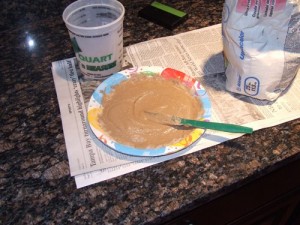 When ever you install ceramic tile you really should keep some of the grout stored in a cool dry place for future repairs. Matching the color of grout later is much easier if you have some. There really are two approaches to this fix. The quick and dirty fix or the complicated repair.
When ever you install ceramic tile you really should keep some of the grout stored in a cool dry place for future repairs. Matching the color of grout later is much easier if you have some. There really are two approaches to this fix. The quick and dirty fix or the complicated repair.
I’m choosing the quick and dirty method because I want to see if this will work. The simple method is to just fill the existing crack with grout. The more complicated method would require removing as much of the existing grout as possible and then re-grouting the joint completely.
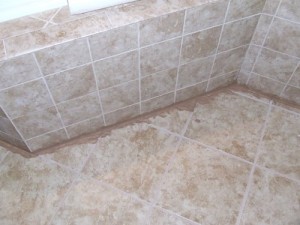 The grout that was used for this project was an un-sanded grout which should be capable of filling the narrow cracks. I mixed up some grout on a small paper plate so that I could throw it away afterward. Then I used my finger to apply the grout to the cracked area. I made the grout a little wetter than I normally would so that I could get it forced into the thin crack.
The grout that was used for this project was an un-sanded grout which should be capable of filling the narrow cracks. I mixed up some grout on a small paper plate so that I could throw it away afterward. Then I used my finger to apply the grout to the cracked area. I made the grout a little wetter than I normally would so that I could get it forced into the thin crack.
Grout Cleanup
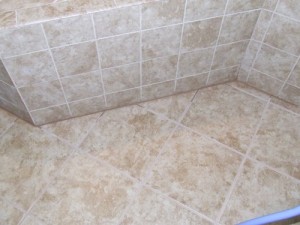 Once I filled the crack the method of clean up is the same as any grouting job. I cleaned off the grout line a couple of times and then washed the surrounding tiles. You want to make sure you get it all off so that you’re not scraping really hard grout off the tiles later. As you can see from the photo the crack is now filled. After the grout completely dries you’ll never know it was cracked before.
Once I filled the crack the method of clean up is the same as any grouting job. I cleaned off the grout line a couple of times and then washed the surrounding tiles. You want to make sure you get it all off so that you’re not scraping really hard grout off the tiles later. As you can see from the photo the crack is now filled. After the grout completely dries you’ll never know it was cracked before.
Repairing Wide Cracks in Grout
If you have wider cracks in the grout or missing grout then it’s time to consider removing the old grout and installing new grout between the tiles. You can use a simple Grout Removal Kit or  I prefer using a Dremel 568 Grout Removal Kit which attaches to my Dremel Tool or the Rockwell Sonicrafter. Once you’ve removed all the old grout then you just install new grout as if it were new construction.
I prefer using a Dremel 568 Grout Removal Kit which attaches to my Dremel Tool or the Rockwell Sonicrafter. Once you’ve removed all the old grout then you just install new grout as if it were new construction.




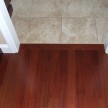










I found your directions totally useless. “Just install new grout as if it were new construction” I could have figured that much all by myself! Thanks you have been a big help!!
Paul – Thanks for being such a colorful guy. If you look at the article, it was focused on hairline cracks. The last part of the article mentions wider cracks and gives a link to another article that shows how to grout tile in new construction. Sorry you felt the information was lacking. Good luck.
Paul; You must need glasses. I can’t believe you bothered to respond so rudely and did not read his instructions carefully. He said this problem with the grout happens with new construction and I only read it once!
Hey Todd. I was wondering if you have any info on repairing grout on a pier and beam sub-floor. The tile went on nicely, but about a month later, the grout started coming out in chunks around the tiles. I did not put down any hardy backer. Do you think that could have been the problem, or do I just need to try a silicone based grout that comes in a tube? Thanks, Scott
Scott – Not really sure what you’re referring to on the “pier and beam sub-floor”. Can you be more specific? Sounds like a deflection issue to be honest.
Some grout has eroded in a very small area on one wall in my shower. Can I just put some grout in those areas ot will I need to regrout the entire shower?
Lonnie – You can grout just small areas. Before you do it I would clean the joint in that area and be sure that all the loose grout is removed. Once you know that the remaining grout is sound then apply the new grout. It’s not likely that the color will match very well though.
Hi: I had ceramic tile put down on my kitchen counter–they removed the old counter and placed the tile, just as your description states, where the wall and counter meet, there are now cracks, I think those will be easy enough to fix but what I found troubling is that where the cracks are in the grout, they have entered the actual tile. Like some of the tiles are cracked now, can that be repaired without removing them? For instance, where the crack is present in the grout, it makes a zig zag crack in some areas which extends the white grout and then the actual beige tile has some crack. I have no idea why this happened. I hope I can fix it. I was worried there was water leaking someplace but I think the moisture as you state is the issue and it just continued like a crack can and went on to include not just the grout line but the tile itself. I almost had a heart attack when I saw it.
Kathleen – This actually sounds like a bigger problem. Grout typically cracks from two things, movement due to material shrinkage (pretty normal and what I wrote about) or too much movement in the sub-base. Because your tiles are cracking I think the later is the problem. Without knowing the specifics it sure sounds to me that the plywood sub-base that supports the tile is probably not stiff enough. If that’s the case then the tile and grout can crack.
Do you know what the supporting sub-base is constructed of? Most people use a minimum of two layers of 3/4″ plywood over the framing before tiling it.
The grout in my standing shower has cracked? Could it have nit meen sealed wirh sealent? And after I fill the cracks can I seal it even if it has already been saealed?
Thank you for your help
Elissa
Elissa – Grout does not crack due to lack of sealant. You should be able to repair the grout, then seal it again.
Good luck
Hi Todd. Our house is about 40 yrs old. We just did over the entie bathroom right down to the studs. We had radient heat put in the floor and hired a professional tile guy who tiled the entire bathroom. After only a few months, he grout is cracking around the tub, window and walls. On the floor it has even come out in small chunks. Do you think that the larger floor chunks could be due to the radient heat? Also, would hairline cracks appear only after a few month? Thanks.
Alysa – Without knowing all the details it’s quite hard to determine the cause. However, in most situations extensive cracking and failure of grout on flat floors is a result of an inadequate sub-floor. Hairline cracks develop routinely in grout where two surfaces meet at 90 degrees, like wall/floor intersections, etc.
Radiant heat is not causing this issue unless the heat is causing a poor sub-floor to move too much under thermal stress.
What is the sub-floor? You really need a minimum of 3/4″ plywood, glued, nailed (preferably screwed), then a tile backer, either cement board or a product like Ditra Schluter.
Hello. A couple of years ago, I had a cermaic tile floor put in my 1st floor. The grout lines now look terrible. The grout almost looks “pitted” and these areas collect dirt so it looks like I’ve got stained areas of grout throughout my house. The sales guy said that we didn’t have to seal this grout because it was “special” grout. HA! How do I fill in all these pitted spots? I really need some help.
Thanks!
Sounds like the grout needs to be removed and re-installed. Grout doesn’t last forever but it should get through 5 years or more unless there are really hard conditions. Removing grout and installing new grout isn’t a very hard task if you’re up for a DIY project.
It appears on the perimeter of my Powder Room- the grout gives off a ghosted feel (looks like baby powder on it) Grout color is cocoa. Is there anyway I can do a quick topical repair with grout overlay b/f the Holidays- grout on top of the existing grout. Cannot afford to have someone come in to do right now. The floor is honed marble rosa verona
Many Thanks!
I would scrub the grout, then try a sealer.
I just wanted to say thank you Todd. I found this very informative and just what I needed to know! Keep up the good work!
Hi Todd,
While I found your site extremely informative I am wondering… A little background, my home was built in 83, I think the bathroom is original to the house. Well the grout is chipping and is cracked. We will be renovating the bathroom next summer. I think the cracks are bad enough that I need to redo it, but I don’t really see the point since we are going to tear it all out anyway. Do you think clear bathroom caulking woould do the trick?
Aimee – Are you asking what you can use between now and next summer? If so there are “sanded” caulking products available at most hardware/big box stores that you can use for a temp fix. Good luck.
Will be touching up some small cracks in the grout, but wonder how long I should allow to dry prior to regrouting. One, two, three days? Keep in mind the small cracks have been there about 6 plus months and we are just now getting around to regrouting…. Any suggestions?
Not sure I understand your question. If the grout has been there 6 months…what are you letting “dry”?
Would this grout fix also apply ti outside tile? I have developed grout cracks in my patio tile, house built 5 years ago
Depends on the type of grout, is it grout or just sand?
This is grout with sand, it is 20″ tile, I live in South Florida where the sun beats on it 364 days a year! I believe we have one overcast day a year lol!
My biggest concern is water intrusion, rainy season coming soon (I hope)
Thank you
yes, the same repair would be applicable. Good luck.
I have a huge brick-walled patio. Had porcelain tile laid over cracked aggregate.. supposedly laid rubber liner over aggregate about 12 years ago. Moisture coming from under the tiles – grout coming up – lot of the tiles loose – other than taking up all the tile and putting down another liner and tile – what can I do? Local tile company wants $25,000 to redo.. could I replace the center of the patio – put in a new liner…leave the stairs which are ok…and put in larger tiles- or?
Karen – without seeing the situation it’s hard to say what the best solution is. From the sounds of it you likely have a couple potential problems. The first situation I’d be concerned about is whether the base has been compacted properly. Also, tile is typically laid over a more stable base like a poured concrete slab or a wood framed floor system. I’ve never seen it installed over just aggregate base regardless of a membrane being installed or not. Lastly, if moisture is a problem it sounds like the surrounding drainage is an issue as well. Wish I could offer more advice, but from what I’m hearing it sounds like you need a slab more than anything. Good luck.
Ok just bought a house and moved in my tile looks like wood planks but there porcelain we noticed some of the grout is cracking and I’m not sure how to properly fix it I think the floors are pretty new but not sure. My husband bought caulking for it but should we use that? It is only small areas. But we do have extra grout what should we do?
Melissa – If you have a way to find out what grout was used previously, then I’d install more grout. Color matched caulking won’t really look as good.
family members tiled our small bathroom floor about 4 years ago, the grout is crumbling and I got some prepared paste type grout to repair it. Our tiles are 18 inch squares.The instructions said not to walk on it for 24 hours. It would be no problem for me, I am small and can just step on the tiles and miss the grout, but my husband has had a stroke and is not agile enough to stay only on the tiles. Is there something I can lay on the floor…cardboard, plastic sheeting, etc…that will allow repair and still use the bathroom..
Nona – It’s not a matter of walking in the center of the tiles, you really shouldn’t walk on it at all. As you walk on the tiles they flex and that prevents the grout from curing properly. If you could do it in the evening and let it stand at least 12 hours that would be helpful.
Thanks…didn’t really solve my problem, but gave insight to what the problem really is…wonder about a pathway of light plywood, would that prevent the flexing..
Dads bathroom is about 40 yrs old. It has only recently having small cracks and some grout coming out. I would only like to fix those small areas. Can I use a non sand grout, or caulk .
Non-sanded grout may work…definitely don’t use caulking
Hi Todd. Thanks so much for the article. My standing master shower was part of a huge reno that was professionally done. We are getting tiny hairline cracks in our grout between tiles on the floor of the shower (not at the 90 degree wall joint). Is that normal? Does it need to be repaired? Is grout water proof anyway?
John – How long ago was it installed. Most grout will get hairline cracks eventually but if it’s new that might be concerning. If the shower was built correctly there is a waterproof pan under the tile so water shouldn’t be an issue.
My white bathroom tile with white grout is original to my 1941-built home. All the walls are tiled 6 feet high. The grout on the bathtub/shower walls needs to be removed and replaced. Any ideas on how to “dirty up” the new white grout? All the walls have been cleaned and the grout bleached, but 75 years of ingrained dust is hard to get rid of completely.
Great question….no idea…maybe some type of natural “stain”…tea?
I just recently put up a backsplash and after apply non-sanded grout I am noticing a lot of hairline cracks all throughout. Should I just add another superficial layer of grout on top of it to hopefully fill in the cracks, or should I use the matching caulk at this point? I wasn’t sure whether you could add more grout on top of grout that already dried. Thanks!
How wide are the grout joints? non sanded is for very narrow joints.
I’ve just tiled a new high end bath in all marble tiles with 1/16″ spacers. This is a radiant floor with 1/4″ durock substrate. Some of the unsanded grout is failing immediately due to some tile movement. Is there a product that I can get between two adjacent tiles that essentially glues them together to eliminate relative movement and therefore grout failure?
Mike – Nothing I know of….even if you found something like that…with that much movement it’s likely the tile will crack. Sounds like the sub-floor is not adequate for that tile.
We moved in our new house 4 1/2 months ago. We’ve had serval issues with the grout. The drain in the shower started getting small holes in it & eventually we ended up with grout washing down the drain. They have put caulk in it for the 3rd time. Now we have 3 places on our floors that are from 1/8″-1/2 long where the grout looks like it pulled away from the edge of the tile. He filled 1 in with sanded caulk. Our small bathroom has hairline cracks in the grout running down beside the tile. It crosses the grout to the next tile. There are some places the crackes seems to be getting wider. Some spots in the grout are darker and have a different texture. Could you please give us some advice? Thanks.
Sounds like you might want to contact another tile guy and get a 2nd opinion. The wrong grout might have been used, the base under the tile might not be sufficient, lots of things could be causing this.
This is a new house in Florida. My husband thinks this could be from the house settling. The house is on a concrete slab. Is this possible?
It’s possible….but it’s more likely poor tile installation in my opinion.
Hi Todd,
I was wondering if I could ask your opinion;
3 months ago we completed a bathroom that we took back to bare brick. We had the shower tiled by a professional tiler. After >48 hours we applied a grout sealer.
It was some time before we ever had a shower because we were waiting on plumbers – who fitted the shower and the glass panel and door.
We have found a leak: all that can be seen is water coming from behind the bottom tile on the outside of the cubicle. The grout of this tile looks darker than the rest suggesting this is wet. We dried it out for >3 days and re applied seal. Allowing >48 hours for this to cure I have just tested it and it’s still leaking.
I am unable to see any deterioration in the grout.
There are no water pipes on this wall, and this is definitely the location of the leak. Is there a product we can use, or do we need to remove the grout and reapply, or [as suggested in your above post] can we grout over the top?
Your advice will be gratefully received (unless it’s take the shower out and start again! ;) ).
Mindy – I’m having a hard time understanding what you mean by a leak…do you think there is water behind the tile that is trying to “wick” out? Do you think water is leaking into the grout joint, then leaking back into the structure? Any additional info can help.
Hey Dude, awesome article, however my grout issue seems to be between the wood transition to the tile.
Having old floors to new floors thought a tile would look cool. it does, however where the grout meets the wood it keeps cracking up. I have had the guy come back and refilled already and his answer was that is all we can do…. Really?
Any other options?
Use sanded caulking…looks like grout but it’s flexible. You can get it colored matched to most grouts.
I have a tricky question that may be related to Mindy’s above. I have a shower stall that is a couple of years old with a plastic floor, two tile walls, and two glass walls. The grout lines in the tile walls are quite thin, and one three inch long crack has appeared in the grout along one wall that is very narrow. We have discovered that water seems to be getting to the sheet rock walls that abut the tile, as the sheet rock slowly becomes damp over a couple of weeks of using the shower. The plumbing looks fine, with no leak stains, etc., and has been checked by a plumber. My only guess is that enough water penetrates the grout to reach the underlying sheet rock, and then slowly seeps to the adjacent corner where it becomes visible. I have thought of simply applying a fine bead of clear silicone caulk over the grout as a seal. Any ideas or suggestions would be most appreciated. Thank you.
Would this quick and dirty method work for grout used in control joints in a stained concrete floor? All the grout (sanded) along all the joints throughout the new construction house cracked; the cracks all seem less than 1/16″ wide (is that “hairline”?). Redoing the joints with polyurea used in industrial and restaurant stained concrete floors is likely cost prohibitive. It looks so terrible, any suggestions for a fix are much appreciated.
First thing is to figure out what caused it. That doesn’t sound normal to me. Is the floor to flexible? Was too much water added to the grout? 1/16″ is wide…may need to remove and start over.
I have hairline cracks in the grout in my shower (vertical wall corners) and the tub surround (horizontal along outside wall). I was thinking of trying your quick fix using sanded color matched caulk because I was told it is more flexible and will not crack. I would appreciate your opinion or recommendation on my thinking as well as should the caulk be sealed after it cures. Our house is 2.5 years old.
better off trying to use some unsanded grout..not caulking
Thank you so much for this helpful article. We just had our shower completely redone and it’s been about one week and the grout (unsanded) is showing cracking, crumbling and pinholes. Can this be fixed by putting new grout over it or does this need to be taken out and regroutted? We aren’t sure what is causing the grout to look this way.
If it’s cracked this soon I think it may have been mixed improperly, with too much water. Probably needs to be removed and replaced.
Our kitchen countertop is finished with dark green granite tiles. The grouting is missing is a few small spots but needs to be regrouted on the whole countertop because the black grout looks old and more recessed than I would like. I would like the grout to be more flush to the tile. Do I have to remove the old grout first or can I just clean it up and grout over?
absolutely